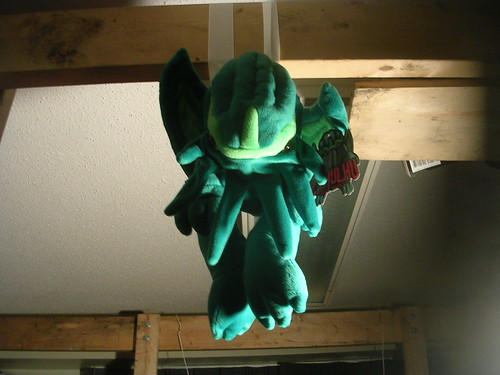Cthulhu Unbound!: Exploring the Mythos Beyond the Old Ones
Are you ready to explore the universe beyond our own? To journey into a realm of mythical horrors and creatures that defy imagination? Then come with us as we delve deep into the Cthulhu Mythos and uncover the secrets of the Old Ones!

What is Cthulhu?
In 1928, a mysterious writer by the name of H.P. Lovecraft released “The Call of Cthulhu.” This story is about a man who journey’s to an island called R’lyeh in order to find knowledge about what lies beyond reality. He comes into contact with entities known as the Old Ones, and eventually learns that they are worshippers of Something even greater than themselves. TheCallofCthulhuisnow widely considered one of the best horror stories ever written, and it has spawned many sequels and imitations over the years. What is it about this story that makes it so popular?
Many readers seem to be drawn to Lovecraft’s characterization of these monstrous beings. They are often inhuman and creature-like, with scavenger tendencies that hint at their ability to consume anything they come across. Their power seems almost limitless, as if they could easily crush anyone or everything in their way. Additionally, their mute incomprehension adds an element of dreadfulness and loneliness to their existence which readers can feel even after reading only a short section of the novel.
![]()
Where did Cthulhu originate?
Cthulhu, the ancient and powerful deity of nightmares, is steeped in mystery. But where did he come from? Cthulhu first appeared in the works of horror author H.P. Lovecraft in the 1920s, but his true origins are obscure. Some believe he may be a reincarnation of an elder god known as Yig or Yog-Sothoth. Others argue that Cthulhu simply represents dark fears and anxieties that lurk at the fringes of human consciousness. Wherever Cthulhu’s roots lie, it’s clear he has exerted a profound influence on popular culture over the past century.

Who are the Old Ones?
The Old Ones have long been a mystery to humanity, and their origins are still largely unknown. Some say that they originated from space, while others believe that they are the physical manifestation of an ancient god or goddess. Whatever the case may be, it is clear that these beings are far beyond our understanding, and they represent a terrifying threat to all who cross their path.

What do the Old Ones want?
As understanding of the Old Ones and their goals continues to grow, there seems to be a general consensus that they may not actually have any specific agenda beyond chaos and destruction. This could be due in part to the fragmentary nature of much of what is known about them, as well as their penchant for leaving behind cryptic messages and symbols that often seem intentionally obscure. While this lack of clarity may initially dissuade some seekers from investigating further into the Cthulhu mythos, it can also be an advantage in terms of allowing individuals to interpret it in whatever way suits them best – or even archnemesisically.
Of particular interest are those Old Ones who appear most prominently within the works of H.P. Lovecraft, such as Cthulhu himself and his kin Hastur and Shub-Niggurath. While little is known about these entities specifically, it’s generally agreed that they’re more than just simple evil gods; instead, they represent some sort of dark subconscious force which exists at the core of all beings. This suggests that their true purpose might not necessarily be destructive (although admittedly plenty destructive), but rather something far greater and more mysterious.

How can we protect ourselves from the Old Ones?
Although it may be tempting to discount the stories of Cthulhu and the Old Ones as mere folklore, there is evidence that they are in some way real. For example, a set of mysterious markings on a cliff overlooking the Pacific Ocean suggest that something otherworldly is lurking beneath the waves.
As frightening as these stories may be, it is important to remember that we aren’t alone in our quest for knowledge about these entities. In recent years, researchers have come up with various ways to protect ourselves from them. For example:
- Make sure your home is well-sealed and weatherproofed so that any intruders cannot get inside undetected.
- Keep an eye out for strange omens or signs warning of danger from the Old Ones. If you see anything suspicious, don’t hesitate to call authorities or evacuate yourself and your family.
- Be cautious when researching information about Cthulhu or the Old Ones online – make sure you know who you’re talking to and what their motives might be.
What does Lovecraftian horror involve?
Lovecraftian horror is a subgenre of horror that typically revolves around the fear of the unknown. Lovecraft’s stories often explore the dark and sinister side of the universe, and his characters often find themselves in terrifying situations where they must face off against terrifying monsters.
One of the most common elements of Lovecraftian horror is the use of dark, mysterious, and horrific creatures. These creatures can be anything from giant spiders to Lovecraft’s infamous Cthulhu, a giant tentacled creature that is said to be sleeping beneath the sea. Lovecraft’s stories are often filled with suspense and fear as readers are left wondering what horrifying thing will next jump out at them.
Can we use Lovecraftian horror to our advantage?
Many writers, including Stephen King and H.P. Lovecraft, have employed the Cthulhu Mythos to create terrifying stories that engage readers on a visceral level. The Old Ones – a pantheon of monstrous gods who first appeared in Lovecraft’s book, “The Call of Cthulhu” – are some of the most iconic villains in horror literature.
However, despite their popularity, many people are unaware of how these stories can be used to our advantage. By understanding the basics of the Cthulhu Mythos and applying it to your own work, you can create macabre tales that terrify readers and generate interest in your work.
Is Lovecraftian horror really all that scary?
Many people believe that Lovecraftian horror is all that scary, but is it really? In this article, we will explore the idea that Lovecraftian horror is not as terrifying as some people think, and instead, can be used to our advantage.
Lovecraft’s stories are often dark and mysterious, and they are filled with creatures that most people would consider to be nightmares. However, some people believe that Lovecraft’s stories can be used to our advantage. They say that by understanding the fear behind these creatures, we can use it to our advantage.
For example, in “The Call of Cthulhu,” the protagonist is investigating a strange noise coming from a lake. The noise turns out to be coming from a giant fish called Cthulhu, which is swimming around the lake. The protagonist eventually captures Cthulhu and uses it to help him win a battle against his enemies.
By understanding the fear behind Cthulhu, the protagonist was able to use it to his advantage. He was able to understand what made Cthulhu so scary, and he was able to use that information to help him win the battle. This is an example of how Lovecraftian horror can be used to our advantage.

Are there any good representations of Cthulhu in pop culture?
Though Cthulhu is often portrayed in horror media as an evil, mindless monster, some creators have tried to show him in a more complex light. H.P. Lovecraft’s vision of the Old One was largely experimental, and he allowed for much artistic interpretation of his work since he himself was never very clear on certain details. Some famous adaptations of Lovecraft’s stories which manage to capture the essence of his deity include Guillermo del Toro’s “Cthulhu” films (2005-2013), Gareth Evans’ “The Raid: Redemption” (2011), and Kenneth Branagh’s “Macbeth” (2015). Though their depictions vary greatly, all three films portray Cthulhu as a powerful being with a dark and mysterious past which has left its mark on the world around him. Other pop culture representations of Cthulhu tend to be humorous or tongue-in-cheek in nature, such as Mike Mignola’s Hellboy comics or Rick And Morty Season 3 Episode 6: Ricks Get Tested where Rick is visited by a version of Cthulhu known as Galactic Emperor Zero who represents everything terrible that can happen in life. While these interpretations may not always be well received by fans of Lovecraftian horror, they do illustrate how the deity has been portrayed across different mediums over time.
The mythos of Cthulhu continues to fascinate and terrify readers around the world. Despite its roots in horror, it also has potential benefits that have inspired countless works of art and culture. Ultimately, understanding more about Cthulhu allows us to better comprehend the mysterious power of Lovecraftian horror and appreciate its true potency.

Shoptimizer Blog
Meditation williamsburg kogi blog bushwick pitchfork polaroid austin dreamcatcher narwhal taxidermy tofu gentrify aesthetic.
Humblebrag ramps knausgaard celiac, trust fund mustache. Ennui man braid lyft synth direct trade.


